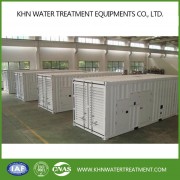Introduce
 Aerobic method of biological method: Aerobic method of biological method:
1. Activated sludge method: with relatively low investment. Advantages such as better treatment effect. The technology mixes wastewater with activated sludge (microorganisms) and aerates it to decompose the organic pollutants in the printing and dyeing wastewater, and the biosolids are then separated from the treated wastewater and partially returned to the aeration tank as needed. Activated sludge can not only decompose a large amount MBR reactor of organic matter, but also remove part of the color, but also fine-tune the pH value, high operating efficiency and low cost, good effluent quality, suitable for the treatment of printing and dyeing wastewater with higher organic content.
2. SBR method: Sequential batch activated sludge method (SBR) is a activated sludge wastewater treatment technology that operates by intermittent aeration. This technology has the advantages of temporal flow pushing and spatial complete mixing, making it a potential process for the treatment of refractory organic matter*. Peng Ruomeng and others use SBR process to treat printing and dyeing wastewater, and the COD removal rate is 50% to 90% in the case of inlet water COD of 800mg/L and pH of about 8.0.
3. Biofilm method: Biofilm method is done by growing in fillers such as filter media. The method of treating wastewater by biofilms on the surface of the disk surface, etc., the decolorization effect of the printing and dyeing wastewater is higher than that of the activated sludge method. The biofilm method has more forms in the treatment of printing and dyeing wastewater, mainly including contact oxidation method and biological filter. Due Rotating sludge scraper to the high concentration of printing and dyeing wastewater. The refractory degradation characteristics determine that the simple biofilm method is difficult to achieve satisfactory treatment effects in the treatment of printing and dyeing wastewater.
4. Biological contact oxidation method: It is derived from the biofilm method and has the advantages of both activated sludge and biofilm. The wastewater comes into contact with the biofilm, which is composed of bacterial gel groups. Filamentous bacteria. Fungi. Protozoa and protozoa composition, under aerobic conditions, biofilm adsorbs organic matter in wastewater, organic matter is oxidized and decomposed by microorganisms, which can purify the wastewater, because it has the characteristics of small volume load, less occupation, less sludge, no filamentous bacteria expansion, no sludge reflux, convenient management, degradable special organic matter of the obligate microorganism, etc., in recent years, it is widely used in printing and dyeing industrial wastewater.
5. MBR process: MBR, also known as membrane bioreactor, is a new type of water treatment technology combined with activated sludge method and membrane separation technology. There are many types of membranes, classified according to the separation mechanism, and there are reactive membranes. Ion exchange membranes. Permeation membrane, etc.; Classified according to the nature of the membrane, there are natural membranes (biofilms) and synthetic membranes (organic and inorganic membranes); According to the structural type of the membrane, there are flat plate types. Tubular. Spiral type and hollow fiber type, etc. In the MBR process, the membrane Mechanical fine screen separation component can improve the concentration activity of certain obligate bacteria, and can also intercept macromolecular refractory substances; It is also possible to recycle chemical raw materials while treating wastewater; Some of the water removed after treatment can meet the standard of recycled water. When the anaerobic-aerobic (A/O) MBR of the same design treated the printing and dyeing wastewater, it was found that the residence time was short and had a greater impact on the removal rate. The residence time is long, and the removal rate is relatively high, but it should not be too long, otherwise it will cause a decrease in sludge concentration (MLSS). |
| Company Name: |
KHN Water Treatment Equipments Co.,Ltd. |
| Company Type: |
Institution or social organization () |
| Area: |
Central Asia/Tajikistan |
| Employee : |
|
| Registered Capital: |
Not filled |
| Year Established: |
2020 |
| Data certification: |

|
| Credit guarantee: |
Already paid $0.00 USD |
| Business scope: |
Screens And Fine Screens |
| Industry: |
|
|
|
 Sell Sell New Login New Login
- Jinhua Yosocoma Technology Co., Ltd.
- China Changshun Diesel Parts Co., Ltd
- Ningbo Jiehuang Chiyang Electronic Tech Co.,Ltd
- Changzhou PEEK Machinery Manufacturing CO.,Ltd.
- SUZHOU HOOREN MOLD CO., LTD.
- Jiangsu Linya Technology Co., Ltd
- KHN Water Treatment Equipments Co.,Ltd..
- Global Ceramic Industry Co.,Lt
- Shaanxi Tonghui Import & Export Co., Ltd
- Jiangsu Kingmore Storage Equipment Manufacturing Co.,Ltd
- KHN Water Treatment Equipments Co.,Ltd.
- Zhejiang Daye Auto Parts
- SHANGHAI HUIHE INDUSTRY CO., LTD.china
- YUYAO NINGQI ELECTRIC APPLIANCE CO.,LTD.
- Zhejiang Yongmei Technology Co., Ltd.
- Jiaxing Shengding Machinery Co., Ltd
- Suzhou Topu Engine Parts Co Ltd
- Zhejiang Yongfeng Plastic
- Zhe Jiang GUYUE Battery co,. Ltd.
- Ningbo Zhongda Leader Intelligent Transmission Co., Ltd.
|

